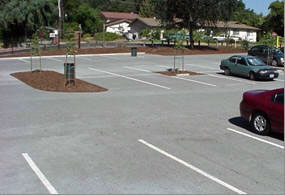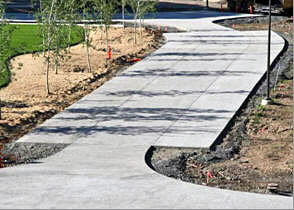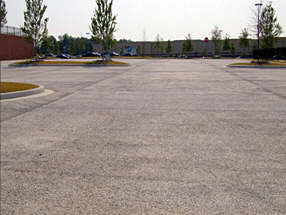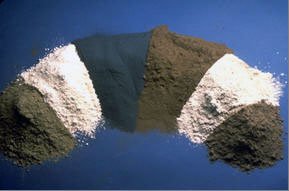Benefits
Using Pervious Concrete to Achieve LEED Points
Benefits | Attractive | Economic | Environmental | Structural | LEED
By: Erin Ashley, PhD
Director of Codes and Sustainability, NRMCA
As appeared in Concrete InFocus, a publication of NRMCA, Winter 2008
 Click here to download a copy of this article
Click here to download a copy of this article
Pervious concrete is a unique and innovative means to manage stormwater. When pervious concrete is used in building site design, it can aid in the process of qualifying for LEED Green Building Rating System credits.

Pervious pavements function like storm water retention basins and allows the stormwater to
infiltrate the soil over a large area, thus facilitating recharge of precious groundwater supplies.
Pervious concrete has been used successfully in many types of construction on applications such as parking lots, streets, plazas, nature trails, and walkways. While pervious concrete can be used for a surprising number of applications, its primary use is in pavement. Pervious concrete is a performance-engineered concrete made with controlled amounts of aggregates, water and cementitious materials to create a mass of aggregate particles cover with a thin coating of paste. A pervious concrete mixture contains little or no sand, creating a substantial void content. Using sufficient paste to coat and bind the aggregate particles together creates a system of highly permeable, interconnected voids that drains quickly. Typically, between 15% and 25% voids are achieved in the hardened concrete, and flow rates for water through pervious concrete are typically around 480 in./hr (0.34 cm/s), although they can be much higher. Both the low mortar content and high porosity also reduce strength compared to conventional concrete mixtures, but sufficient strength for many applications is readily achieved.
Pervious concrete pavements are usually supported on a base layer of uniformly sized stone to form a basin where rainwater can be stored before percolating into the soil below. The system basically forms a dry detention pond which can reduce the need for expensive stormwater drainage and wet pond detention/retention systems, thereby allowing for more effective land use. In effect, the pervious concrete pavement system serves two functions: 1) as a paved surface for driving, parking or walking, and 2) as a retention basin for storing rainwater during a storm event.
Leadership in Energy and Environmental Design (LEED®) is a rating system developed by the United States Green Building Council (USGBC) to evaluate the environmental performance of a building. The LEED is a voluntary, consensus-based national standard for developing high-performance, sustainable buildings.

Pervious concrete can offer a durable, yet permeable, surface capable of supporting heavy traffic loads.
LEED provides a framework for evaluating building performance and meeting sustainability goals through five credit categories: sustainable site development, water savings, energy efficiency, materials selection and indoor environmental quality. It should be noted, however, that LEED points are not gained directly by the use of a product but by meeting a specific sustainability goal of the rating program. Pervious concrete can contribute to many LEED categories including: Sustainable Sites, Water Efficiency, Materials and Resources, and Innovation in Design.
Specific credits where pervious concrete can aid the designer include:
LEED Credit SS-C6.1 Stormwater Design - Quantity Control
LEED Credit SS-C6.2 Stormwater Design – Quantity Control
The intent of these credits is to limit disruption and pollution of natural water flows by managing stormwater runoff, increasing on-site infiltration and eliminating contaminants. Pervious concrete can contribute to this credit by reducing stormwater flow by allowing water to soak through and infiltrate to the ground below. Pervious concrete can also reduce the pollutant loads by filtering contaminants as the water is transferred through the pavement. On building sites where the existing imperviousness is greater then 50%, credit SS-C6.1 requires reducing the rate and quantity of stormwater runoff by 25% from the two-year, 24 hour design storm. On building sites where the existing imperviousness is less than 50%, the requirement specifies that the post-development peak discharge rate and quantity from the site shall not exceed the pre-development peak rate and quantity. Generally, by incorporating a pervious concrete pavement system on site, the project can meet these criteria and thus obtain the LEED points for these credits.
LEED Credit SS-C7.1 Heat Island Effect—Non-Roof
 The Intent of this credit is to reduce heat islands (thermal gradient differences between developed and undeveloped areas) to minimize impact on microclimate and human and wildlife habitat. This credit requires any combination of the following for 50% of the site hardscape (sidewalks, parking lots, drives and access roads), shade within 5 years of occupancy, paving materials with a solar reflectance Index of at least 29 or/and an open grid paving system. A second method to achieve this credit includes providing under cover parking areas for 50% of the parking spaces. Pervious concrete acts to reduce the heat island effect of concrete by absorbing less heat from solar radiation than darker pavements. The relatively open pore structure and the light color of pervious concrete stores less heat, therefore, reducing the heat reflected back into the environment and helping to lower heat island effects in urban areas. The heat island effect can be further minimized by the addition of trees planted in parking lots. The trees offer shade and produce a cooling effect for the paving. Pervious concrete pavement is ideal for protecting trees in a paved environment (many plants have difficulty growing in areas covered by impervious pavements, sidewalks and landscaping, because air and water have difficulty getting to the roots). Pervious concrete pavements or sidewalks allow adjacent trees to receive more air and water and still permit full use of the pavement pervious concrete.
The Intent of this credit is to reduce heat islands (thermal gradient differences between developed and undeveloped areas) to minimize impact on microclimate and human and wildlife habitat. This credit requires any combination of the following for 50% of the site hardscape (sidewalks, parking lots, drives and access roads), shade within 5 years of occupancy, paving materials with a solar reflectance Index of at least 29 or/and an open grid paving system. A second method to achieve this credit includes providing under cover parking areas for 50% of the parking spaces. Pervious concrete acts to reduce the heat island effect of concrete by absorbing less heat from solar radiation than darker pavements. The relatively open pore structure and the light color of pervious concrete stores less heat, therefore, reducing the heat reflected back into the environment and helping to lower heat island effects in urban areas. The heat island effect can be further minimized by the addition of trees planted in parking lots. The trees offer shade and produce a cooling effect for the paving. Pervious concrete pavement is ideal for protecting trees in a paved environment (many plants have difficulty growing in areas covered by impervious pavements, sidewalks and landscaping, because air and water have difficulty getting to the roots). Pervious concrete pavements or sidewalks allow adjacent trees to receive more air and water and still permit full use of the pavement pervious concrete.
Pervious concrete has not been explicitly approved for use in SS 7.1 for its high albedo properties; however, the pervious concrete design may be submitted for interpretation. If the concrete producer has reflectance of test results for the pervious concrete mix used on the project, he may choose to submit a letter to the contractor (and architect) indicating the results of the tests, increasing the chance that the SS 7.1 credit will be awarded.
LEED Credit WE C1.1 Water Efficient Landscaping
The intent of this credit is to limit or eliminate the use of potable water, or other natural surface or subsurface water resources available on or near the project site, for landscape irrigation. To earn this credit, potable water for irrigation must be reduced by 50% when compared to a mid-summer baseline case. The gravel sub-base under pervious concrete can be used to store stormwater for irrigation, helping to satisfy this credit. If no irrigation is required for a project, two points may be earned.
LEED Credits MR-C4.1 AND MR-C4.2 Recycled Content

Supplementary cementitious materials.
From left to right, fly ash (Class C), metakaolin (calcined clay), silica fume, fly ash (Class F), slag, and calcined shale.
The intent of this credit is to increase the demand for building products that have incorporated
recycled content material reducing the impacts resulting from the extraction of new material. The requirements for these credits are the use of materials with recycled content such that the sum of post-consumer recycled content plus one-half of the pre-consumer recycled content constitutes at least 10% or 20% (based on the dollar value of the material), respectively, of the total value of materials in the project. Almost all ready mixed concrete contains recycled materials in the form supplementary cementitious materials (SCM) such as fly ash, slag, or silica fume. The use of SCMs or recycled aggregate in pervious concrete or base material contributes to recycled content needed for this credit. SCMs are considered pre-consumer recycled material and recycled aggregate from a demolished project are considered post-consumer recycled material.
LEED Credit MR-C5.1 AND MR-C5.2 Regional Materials
The intent of this credit is to increase demand for building products that are extracted and manufactured locally, thereby reducing the environmental impacts resulting from their transportation and supporting the local economy. To meet the intent of this requirement, 10% (based on cost) of the total materials must be harvested, extracted or recovered within 500 miles of the project site. An additional point is awarded for 20% regional materials. The majority of materials in pervious concrete, and most ready mixed concrete, are considered regional materials. Projects with large amounts of concrete can meet the required 10% or 20% regional materials to meet this credit.
In addition to aiding in gaining LEED certification points, pervious concrete can provide a safe and durable surface for most pavement needs. Light colored pervious pavements require less site lighting to provide safe night-time illumination levels, whether on parking lots, driveways, or sidewalks. Pervious concrete used in walkways or in parking lot applications drain water quickly removing it from the surface to reduce ponding. This decreases the slickness of the walking surface and reduces the chance of slips and falls. Pervious concrete requires little or no maintenance over time and is considered a durable alternative to asphalt or other paving materials.
Pervious concrete is a perfect material for the environmentally conscious business owners for use in parking lots, drives, plazas, and walkways. With its environmental and safety benefits, pervious concrete can provide a low-maintenance and durable paving material that will assist in gaining the highly regarded LEED certification.
References
RMC Research Foundation, Ready Mixed Concrete Industry LEED Reference Guide, Silver Spring, MD, www.rmc-foundation.org, 2006.
Ferguson, B. Porous Pavement: The Overview, 2006 Concrete Technology Forum, NRMCA, 2006.
http://www.concreteparking.org/pervious/index.html


